Detector Group Enhances Mammography X-Ray
- Liaison staff serve the Lab's many users
Jefferson Lab Receives Award from DOE
Small Business Advocacy Team Members
- Employee serves as resident bird expert
Associate Director Begins Position at OSTP
Health Videos Available for Check-Out
- Summer students gain valuable insight
Exploring the World of Magnets
- Student travels to Germany to research magnetic monopoles
- Brooks takes it all in stride
USER FRIENDLY
Liaison staff serve the Lab's many users
Walking down the hall of the second floor A wing in CEBAF Center can be a cultural experience. At any given time, groups of men and women from France, England, and Armenia, crowd into room A204 asking about physics proposals, training, room allocation, housing, computer availability and directions to a great hamburger. Answering the questions are the staff of Jefferson Lab's User Liaison Office (ULO).
The ULO provides numerous services to the hundreds of users who visit Jefferson Lab. Upon arrival at Jefferson Lab, Users are instructed to go to Room A204 in CEBAF Center. Once there, they can be entered into the Laboratory's Central Information System (CIS) giving them access to the site during normal and after-work hours. They can get information on physics proposals and take the required Environmental, Health & Safety proficiency exams to gain access to the accelerator site. They can also obtain a Jefferson Lab identification badge, EH&S training study guides and office space. The ULO can even enroll users in a visitor's health insurance program.
 "The people at the User Liaison Office have done everything from investigating taking over my J-1 visa sponsorship from MIT and checking into my eligibility to participate in the Jefferson Lab Visitor's Health Insurance Program, to providing a rather useful checklist for helping me get settled at the laboratory," says Kevin Fissum, a Canadian citizen and postdoctoral fellow at MIT who is doing research at Jefferson Lab. Providing a central location for users to obtain any laboratory-related information, ULO provides for interesting work, says Rhonda Barbosa, a ULO student intern. Barbosa says she enjoys the variety of work she experiences in the office. "Working in the User Liaison office gives me the opportunity to encounter something new and exciting everyday. The staff is great, and we really work hard to provide the users with all the information they need. I also get to meet a lot of interesting people from all over the world," says Barbosa.
"The people at the User Liaison Office have done everything from investigating taking over my J-1 visa sponsorship from MIT and checking into my eligibility to participate in the Jefferson Lab Visitor's Health Insurance Program, to providing a rather useful checklist for helping me get settled at the laboratory," says Kevin Fissum, a Canadian citizen and postdoctoral fellow at MIT who is doing research at Jefferson Lab. Providing a central location for users to obtain any laboratory-related information, ULO provides for interesting work, says Rhonda Barbosa, a ULO student intern. Barbosa says she enjoys the variety of work she experiences in the office. "Working in the User Liaison office gives me the opportunity to encounter something new and exciting everyday. The staff is great, and we really work hard to provide the users with all the information they need. I also get to meet a lot of interesting people from all over the world," says Barbosa.
In addition to servicing new users, the ULO acts as the storehouse for the 164 experimental proposals submitted to Jefferson Lab, and the staff works closely with the User Liaison, Roy Whitney. Whitney facilitates Lab interaction with the users. The office also plays an important role in both the Technical Advisory Committee (TAC) and the Program Advisory Committee (PAC), the two experimental proposal reviewing committees at Jefferson Lab. Copies of PAC reports and an enormous amount of other Jefferson Lab related information have been made available on the World Wide Web through the ULO. Additionally, the office was responsible for compiling 674 proposed talks for the International Conference on Particles and Nuclei (PANIC) held last May at the College of William & Mary.
In fact, the ULO manages Jefferson Lab's home page on the Web. The Web is used as a tool to communicate with the Users Group and other guests. Karen Hokansson, Jefferson Lab's WebMaster and ULO manager says, "With the advent of the Internet and the World Wide Web, people want and need information in real time. By creating and maintaining a resourceful Web site, we are better able to serve our customers."
The Jefferson Lab home page provides users and other guests with information about the laboratory's science education program, meetings, conferences, special events, technology transfer projects and the physics program. Users can also access information about the Hampton Roads area, including weather and directions to local restaurants. In the future, the ULO plans to use the Web for EH&S proficiency testing.
The many services that the ULO provide are essential to the successful operation of Jefferson Lab because of the large number of users who conduct experiments here, says Hokansson. She adds that the User Liaison Office is doing their best to help make Jefferson Lab a world-class facility. "The ULO's first priority is to continually achieve high levels of customer service," says Hokansson. "This focus will provide the Users with an environment that supports the successful running of their experiments and Jefferson Lab's physics program."
JEFFERSON LAB RECEIVES AWARD FROM DOE
Jefferson Lab's continued support of small businesses was the impetus of the first Oak Ridge Operations Office Small Business Award on July 30, 1996. The award was presented to the laboratory for its procurement support of small businesses, minority-owned businesses, and women- owned businesses during fiscal year 1995.
During the presentation made by the Department of Energy Site Office, Jefferson Lab was recognized for the many procurement awards it has won in the past and for its increased efforts to use small businesses. "Since 1990, Jefferson Lab has won four Secretary of Energy awards," said Dean Helms, DOE Site Office Manager. "Small business use has increased 34 percent, small disadvantaged-owned business use has increased 380 percent and women-owned business use has increased 164 percent." According to Wayne Skinner, DOE Site Office Contracting Officer, these increases mean, "Jefferson Lab is a leader not only within the Oak Ridge family but it is a leader within the DOE."
 Hermann Grunder, Jefferson Lab Director, accepted the award on behalf of the laboratory stating that, "It means a lot that Oak Ridge deemed it appropriate to give us this recognition." The award, said Grunder, would not have been possible without the efforts of the Procurement department. Mark Waite, Procurement Director, and Danny Lloyd, Purchasing Manager and SURA's Small Business Representative, were thankful for their hard work and dedication to the small business program. Waite credited the success to the "wide spread support we have across all divisions."
Hermann Grunder, Jefferson Lab Director, accepted the award on behalf of the laboratory stating that, "It means a lot that Oak Ridge deemed it appropriate to give us this recognition." The award, said Grunder, would not have been possible without the efforts of the Procurement department. Mark Waite, Procurement Director, and Danny Lloyd, Purchasing Manager and SURA's Small Business Representative, were thankful for their hard work and dedication to the small business program. Waite credited the success to the "wide spread support we have across all divisions."
Lloyd acknowledged not only the buyers in the Procurement department, but the members of the small business advocacy team. The team is composed of 13 staff members from each division, and is responsible for spreading the word about the small business program. "The advocacy team is procurement's eyes and ears in the field," said Lloyd. "They let everyone know that there is a small business program at the laboratory, and encourage staff to use small businesses as a vendor whenever possible."
Small Business Advocacy Team Members
| Bob Bennett | Dick Brazzale |
| Steve Christo | Randy Hartman |
| Deborah Hyman | Larry Munk |
| Julie Oyer | Tim Reid |
| Bob Rice | Henry Robinson |
| Jack Segal | Ronnie Smith |
| Doug Tilles | Janet Tyler |
WATCH THE BIRDIE
Employee serves as resident bird expert
Denise Vitale is one Jefferson Lab employee who is definitely for the birds. She has had two articles and several pictures published in three international bird magazines. She's also the owner of two love birds, six Amadines, and seven Javas. Vitale says being a bird breeder is her way of giving back to the bird community.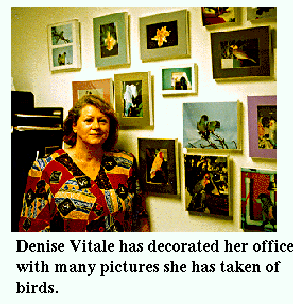
"There is not very much written about Javas, and a lot of people have not hand fed them. So when I did it, I kept a diary. I thought it was information that would be valuable to other bird breeders," said Vitale.
Recently Vitale had two articles published, one in the June issue of Bird Breeder magazine called, "Diary of a Java Rice Bird Breeder," and the other which will soon be released in Bird Talk magazine, called "A Bird at Work." Pictures of birds taken by Vitale are featured in the article. Vitale also had pictures of her birds published in the April and July issues of Bird Talk magazine. At the request of the magazines, Vitale will continue to submit pictures of her birds as she takes them.
Her large collection of birds has also won awards. "I've placed in the top 10, three times with my British Finches and Javas. My goal was to show birds that I've had the parents of, so I've raised those babies. I accomplished this goal last year," said Vitale.
When Vitale started at Jefferson Lab, four years ago, she worked as secretarial support for the Accelerator Division. Vitale now assists the Division Operations Manager, creating and maintaining numerous databases for the division, and serving as a recorder for the Suggestion Committee, Technical Stockroom Quality Improvement Team, and the Technical Education Enhancement Team.
"What I'm doing now is a bigger challenge," said Vitale. "I feel that being a recorder on the committees working with other divisions, helped me to get a broader perspective of the lab, and I feel like I'm contributing more to the lab as a whole."
Although Vitale has no plans of becoming a professional bird photographer, she is extremely pleased with the response she has received from her articles and pictures.
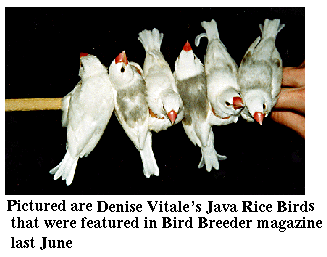 "Lot's of times when people here find out that I know a little about birds they will come to me with questions or ask me if I have an article or something on a specific type of bird," said Vitale.
"Lot's of times when people here find out that I know a little about birds they will come to me with questions or ask me if I have an article or something on a specific type of bird," said Vitale.
For Vitale, writing about birds is a second hobby that came about unexpectedly. "I didn't expect all this to come from it, so it's really nice," said Vitale. "I never planned on breeding either, I just wanted a bird to look at and listen to. The birds made the rest happen."
ASSOCIATE DIRECTOR ACCEPTS POSITION AT OSTP
Associate Director and Project Manager, Beverly Hartline, has been selected for a one-year appointment as the Assistant Director of Physical Sciences and Engineering in the U.S. Office of Science and Technology (OSTP) - the office responsible for assisting the U.S. President in the development of national science and technology policy.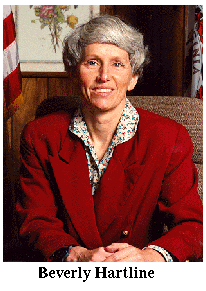
Hartline will assist the office in their analysis, development, advocacy and implementation of Presidential policy on various science and technology issues, particularly those related to the physical sciences and engineering.
An employee since 1985, Hartline has been responsible for project management of the construction phase of Jefferson Lab since 1989. In 1990, she assumed responsibility for the Lab's pre-college science and math education programs.
The Office of Project Management, including its education program, has been incorporated into the Director's Office.
HEALTH VIDEOS AVAILABLE FOR CHECK-OUT
Have you seen C. Everett Koop on television recently, promoting a new Time/Life series of health-related videos? Jefferson Lab has purchased a number of these videos for the benefit of the staff. They are available in Medical Services for a one-week check-out.
If, after viewing a tape, you have questions and would like an appointment with Jefferson Lab's physician, please call Medical Services at X7539 to schedule a time for a confidential conference. Please keep in mind that you should see your personal physician promptly for non-work-related health problems.
- Titles now (or soon to be) available:
- Alcoholism
- Insomnia
- Coronary Heart Disease
- Stroke
- Prostate Cancer
- Breast Lumps
- Back Pain (Lower Back)
- Depression
- Breast Cancer
- High Blood Pressure
- Overweight & Obesity
- Prostate Disorders
- Colon and Colorectal Cancer
- Stress & Anxiety
There are also Time/Life science education videos available in the Jefferson Lab library. For
more information on the following videos, call X7524.
- The Science Almanac for Kids
- Science Starter
- Structure of Matter
- Simple Experiments
"REAL WORLD" LEARNING
Summer students gain valuable insight
Twenty-two year old Ricardo Walker stares at the thin, laminated mylar and kevlar window as it bubbles - stretching and pulling as water presses in from behind. The Virginia Union University senior wants to see how much pressure the window can take before it bursts. The project is part of his participation in COUPR, a Jefferson Lab summer program for promising undergraduate physics students.
Walker's experiment, "Vacuum Window Material Testing," helps ensure that the Laboratory's accelerator beam will safely pass through the windows of Hall C's High Momentum Spectrometer (HMS) and the Short-Orbit Spectrometer. The large HMS vacuum window must hold nine tons of atmospheric pressure when operational, and yet it is only 0.015 of an inch thick. "The window has to be thin enough for the beam to pass through and strong enough to hold vacuum," says Walker.
"Splash!" The window bursts open with water erupting to the floor. Walker analyzes the results and repeats the process 20 times before reporting his findings to his mentor, a Hall C physicist.
Walker is one of several new faces on the Jefferson Lab campus this summer. In June, 32 undergraduate and graduate physics students from 18 colleges across the country and five world-wide, participated in at least one of three annual summer programs. Walker is one of six students in COUPR, which stands for CEBAF Outstanding Undergraduate Physics Researchship. The program, now in its second year, offers promising physics students real-world experience in a laboratory setting - an opportunity usually reserved for graduate students.
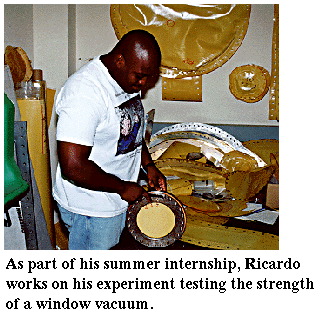 Other summer students attend the laboratory's graduate programs - the 11th Annual Hampton University Graduate Studies (HUGS) and the SURA/Jefferson Lab Graduate Fellowship program. HUGS is a three-week school where graduate students attend daily lectures, interact with leading experimental and theoretical physicists, and publish a scientific paper in the HUGS at Jefferson Lab Proceedings.
Other summer students attend the laboratory's graduate programs - the 11th Annual Hampton University Graduate Studies (HUGS) and the SURA/Jefferson Lab Graduate Fellowship program. HUGS is a three-week school where graduate students attend daily lectures, interact with leading experimental and theoretical physicists, and publish a scientific paper in the HUGS at Jefferson Lab Proceedings.
"HUGS gives you a lot of ideas in preparing your Ph.D. thesis because of the different lecture topics," said Ho Meoyng Choi. One of last year's HUGS lectures, "Light-Cone Quantum Chromodynamics," is the subject of Choi's fellowship and Ph.D. thesis research. Choi's participation in HUGS last year resulted in his acceptance as a graduate research assistant in the Theory Group.
Fellows from SURA member institutions can conduct research at their home institutions to enhance their coursework, or like Choi, receive summer positions at Jefferson Lab. The aim of the SURA/Jefferson Lab Fellowship program is to give outstanding students the opportunity to strengthen their research capabilities and further assist SURA member institutions in expanding graduate training in nuclear physics, accelerator physics, and related fields.
"The purpose of our summer programs is to introduce young people to the exciting science at Jefferson Lab," says Dr. Nathan Isgur, Director of University Relations. "The expectation is that some of the brightest minds will pursue careers that will lead them to a job here or to a university research position where they use our facilities."
EXPLORING THE WORLD OF MAGNETS
Student travels to Germany to research magnetic monopoles
While many of Jefferson Lab's employees have traveled overseas to work at international laboratories, the opportunity is usually not available to the most scholastically apt students at the Laboratory. However, for one Jefferson Lab student that opportunity presented itself last March.
Devin Walker, a junior physics major at Hampton University (HU) and a student researcher in the Lab's Theory Group, traveled to Guttenberg University in Mainz, Germany, to conduct groundbreaking research on magnetic monopoles.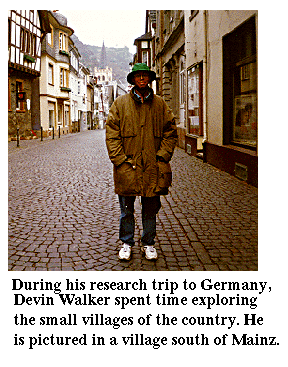
For two weeks, Walker lived and worked at the University's Institute for Nuclear Physics. With help from Warren Buck, Walker's advisor and a researcher in Jefferson Lab's Theory Group, Walker continued work on a theory that, with experimental measure, would place limits on the existence of a magnetic monopole.
Walker is faced with a difficult task since all magnets occur in pairs, with a north pole and a south pole. When a magnet is cut, that north and south pole still exist, no matter how small the magnet is. By placing a magnet in the hydrogen atom, the resulting energy level shifts of the atom will determine the existence of the magnetic monopole. "It's a fun experiment to look at," says Walker. "People are very interested in it because the magnetic monopoles existence can prove other theories." Walker's trip was funded by HU's Nuclear High Energy Physics Center of Excellence. Without this opportunity, he would not have been able to travel to Mainz, and a valuable part of his research would have been affected, says Walker.
"I was at a point in my research where I had been struggling for three or four months. I went to Germany to conduct research and work on a computer program that analyzes the hydrogen atom, a central part of my theory." Unfortunately, two weeks was not enough time for Walker to accomplish all that he needed to, and he never got the chance to work with the computer program. "I was so busy with other aspects of my research that I never got the chance to use it," says Walker.
With this experience, Buck says that Walker will have a great advantage over other students when he progresses to the graduate- and doctoral-levels of his education. "This trip gave him the ability to set up a working collaboration with physicists from a different country, and it gets him working on an interesting problem that, if solved, will be dramatic,"says Buck.
Buck adds that this is the best time for Walker to start a research project of this magnitude. "I wouldn't recommend this problem to a graduate student because he may not be able to solve it due to time constraints," says Buck. "As an undergraduate, Devin is learning a lot of techniques and a lot of physics that he can use in many other problems."
Walker has only positive things to say about his experiences in Germany. "The people at Guttenberg University are the best in their field," says Walker. "This trip will be something that will benefit me the rest of my career in the world of physics."
 New Phone Numbers
New Phone Numbers
On September 23rd, several new telephone numbers were implemented at Jefferson Lab . The lab-wide prefix was changed from 249 to 269 and staff with an extension beginning with 4 or 8 were switched to extensions beginning with 5, 6, or 7. This brings the lab under one prefix instead of the two previously being used (249 and 884).
The change is a result of a shortage of telephone numbers across the entire nation. The popularity of cellular phones and fax machines caused Bell Atlantic to run out of telephone numbers. The Director's Council decided to bring the lab under one prefix and to lease 3,000 new telephone numbers from Bell Atlantic. These numbers will cover the telephone systems in the new ARC building, the new FEL building and the Accelerator Tech Support building.
On July 1, 1996 the area code for the Peninsula and Tidewater was changed from 804 to 757. This change and the new Jefferson Lab phone numbers are on recordings that outside callers hear when they dial incorrectly. These recordings will be effective until November 1, 1996. For more information, contact Lois Lucas at x7361.
On Target Briefs
A new timely source of Jefferson Lab news and information is now available via e-mail. As an extension of the monthly newsletter, a new weekly report entitled, On Target Briefs, provides news directly from the chambers of the Director's Council and other news of interest from around the laboratory. Subscribers will be able to read about information that may effect them as workers at Jefferson Lab.
To receive a copy, subscribe by sending an e-mail message to: mailserve@jlab.org. Leave the subject line blank. In the message area type: subscribe on-target-briefs. Delivery will take place every Monday. A hard copy version is available by request only. To be placed on the hard copy mailing list, or to submit a news idea, contact Deborah Hyman at ext. 5102 or by e-mail at hyman@jlab.org.
OPERATIONS WORKSHOP A SUCCESS!
The inaugural Accelerator Operations Workshop, hosted by Jefferson Lab in late June, may have started something. Greeted by an enthusiastic response from 65 attendees from 21 labs, the workshop will make an encore performance at a yet-to-be-determined site in the summer of 1998.
The event, which was organized by workshop chairman Ron Lauze, lasted four days and provided a forum for the exchange of ideas for Operations professionals. Attendees were kept busy by a full schedule of speakers, addressing a wide variety of topics, such as operator training, accelerator maintenance techniques, control software, and even the effects of sleep deprivation. The presentations were followed by lively roundtable discussions, which permitted the free flow of ideas and the exchange of information. The workshop wrapped up with a tour of Jefferson Lab, including the Machine Control Center, Hall C, and the accelerator tunnel.
COMPENSATION AND BENEFITS
Brooks takes it all in stride
Navigating through salary increases, health care packages, and disability leave is enough to make every Jefferson Lab employee feel faint. Fortunately, Jefferson Lab has Milton Brooks to guide employees through the sometimes rough waters of Compensation and Benefits.
As Compensation and Benefits Manager, Brooks recommends salary rates for every employee at the Lab, including new employees, employees transferred to a new division, and those receiving promotions. Annually, Brooks must prepare a proposal to the regional Department of Energy Office recommending general salary increases for the Lab as a whole. On an individual level, Brooks serves on the Salary Committee, along with the Associate Directors and the Human Resources Director, which determines salary increases for each employee at Jefferson Lab. He also oversees the benefits office which assists employees in choosing a health care package, establish a plan for retirement, decide how much vacation and sick leave each employee receives and determine rules for long and short term disability.
Brooks came to the Lab last March after working in the education environment for seven years. He admits that working in education and working in a scientific atmosphere are two different worlds. "It was tough here at first because I had to acquaint myself with what the physicists and engineers do in order to make sure our pay rates stay competitive," says Brooks. "I came to the Lab because it was a challenge and I wanted to be part of a growing organization."
Brooks has worked in human resources since his career began more than 20 years ago. His first professional job was with the city of Hampton in the Personnel Department. "It was my task to determine the importance of each job and how they fit into the pecking order within the city," says Brooks. It was during his 12 years with the city of Hampton that he became hooked on human resources. "During that time I really fell in love with personnel work," says Brooks. "It is as though this career was made for me." Later, Brooks went on to become Compensation Manager with the Williamsburg/James City County Public School System and the College of William and Mary. Brooks says his attraction to compensation and benefits work stems from the ability to meet all types of people. In an environment as diverse as Jefferson Lab, Brooks is in "seventh heaven." "As the compensation and benefits manager, sooner or later I am going to meet every person in the organization," says Brooks. "Some days I counsel people about things that are not even related to human resources. They seek me out because they value my advice and I have been able to help them before," says Brooks. "When that happens, I go home at night and feel a sense of accomplishment." A native Virginian, Brooks often travels away from home. He has ventured as far north as Atlantic City and as far south as St. Maarten in the Caribbean. He even went to the Olympic Games in Atlanta. "I had the chance to sit in the Olympic Stadium with 85,000 other people and watch track and field events," says Brooks. "It was the most electrifying experience I have ever had and now I am hooked on the Olympics. I am even considering saving my pennies and going to Sydney, Australia for the Olympics in 2000."
BEAMS OFF AND FLYING





The 1996-97 Jefferson Lab BEAMS program is off to a flying start. The year started the week of September 30 with 6th graders from Huntington Middle School in Newport News. The students took a tour of the lab, participated in a slow bicycle race, performed experiments with liquid nitrogen, and tested the flight of paper airplanes (left). This year the education program will host 54 classes from 10 schools in Newport News, Hampton, York County, and Williamsburg/James City County.
CONFLICT OF INTEREST
on occasion, individuals may find themselves in moral and ethical dilemmas in making decisions about involvement in activities that may create or appear to create a conflict with the interests of the Laboratory.
Conflicts occur when outside activities or interests might have the potential to interfere with effective job performance or impair the judgment or ability of individuals to act in the best interests of the Lab. Admittedly, outside business activities such as consulting for others can be of benefit to the employee and to the Lab. However, in all business dealings one must exercise prudent judgment to avoid situations where one's loyalties may be divided or questioned, particularly in situations involving sensitive procurement, intellectual property, personnel decisions, and outside employment activities.
In all business dealings one must be ever mindful to minimize the potential for conflict of interests by conforming to established standards of professional business conduct and integrity. Further, company policy requires the disclosure of any outside business association and annual resubmission of requests to engage in outside business activities. Last December, Hermann Grunder issued a memorandum to all employees that summarized some of the Lab's basic principles with regard to conflict of interests.
As a reminder, they are as follows:
- Competing and conflicting professional interests between the individual staff member and the Laboratory will be resolved in favor of the Laboratory.
- Preferential treatment resulting or arising from employment must = be avoided; therefore, even when there is not real conflict of interest, the appearance of one must also be avoided.
- Any work done for the Department of Energy or DOE contractors is considered "on the clock" and no additional payments may be accepted for such work. Any other work must be done "off the clock."
- The Laboratory's resources (equipment, machinery, computers, stationery, clerical help, etc.) may not be used for outside interests. The Administrative Manual can provide answers to questions on the Lab's Conflict of Interest policy and guidelines.
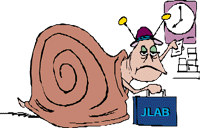 NEW TIME SHEET SYSTEM BEGINS
NEW TIME SHEET SYSTEM BEGINS
Say good-bye to paper time sheets. An Electronic Time Reporting (ETR) system is now the norm for Jefferson Lab staff, eliminating over 600 paper forms every pay period. ETR is a version of the time sheet system used by the Accelerator Division. An Implementation Task Force (Jami Benson, Maureen Davis, Mark Davis, Bill Kozma, Elizabeth Lawson, Mike Syptak) expanded on the system to allow all Lab staff to enter and verify their time electronically. This data will be transmitted electronically to Payroll after approval by a supervisor.
The new ETR will significantly reduce the processing time within the divisions, eliminate missing time sheets, permit electronic signatures with automatic routing to supervisors, provide an improved format to check for and correct errors, and allow for automation of Payroll actions/checks. Leave balance information is also available to each staff member via the new system.
After numerous tests and evaluations by a cross section of lab staff, the ETR was implemented on October 1. For more information, contact Maureen Davis at X-7503, Jami Benson at X-7620, or any member of the Implementation Task Force.
I WANT MY SWIS TV!
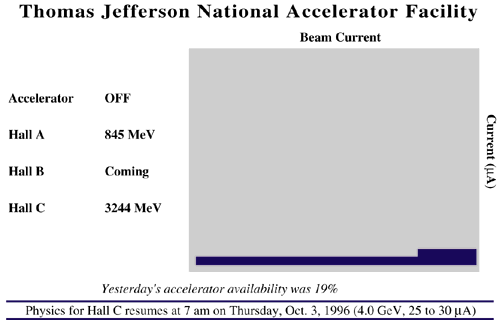
The dissemination of information is a hot topic at Jefferson Lab. To aid in providing accelerator information to employees and users, the Physics and Accelerator Divisions have jointly launched the SWIS Screen. SWIS, an acronym for Site Wide Information System, is a television system that displays up-to-date information about the accelerator and the experimental halls. The system alternates between two screens; one displays how much current is being delivered to each hall in microamps, and the other displays the energy that the beam is running in each hall. Each screen is accompanied by a line graph that displays how much beam current has been delivered during the past eight hours. The screens have the capability to display other types of information, but are mainly designed to support Jefferson Lab's scientific purpose. Thirteen televisions are located throughout the site.
| Editor Deborah Hyman |
Photographer Writer Camille White |
Writer Rebecca James |

